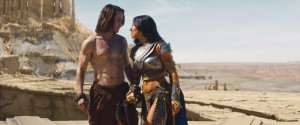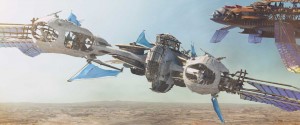
Cinesite spent over two-and-a-half years working on Oscar-winning filmmaker Andrew Stanton’s first live-action feature film. Senior visual effects supervisor Sue Rowe headed up Cinesite’s efforts, working closely with Stanton and spending several months on set in the U.K. and Utah. Rowe and her team of more than 300 people were called on to deliver Cinesite’s most complex and creative work to date for Stanton’s vision of the Edgar Rice Burroughs‘ series of novels
Due to the volume and complexity of the work Cinesite divided the shots between four additional visual effects supervisors – Jon Neill, Christian Irles, Ben Shepherd and Simon Stanley-Clamp. Artemis Oikonomopoulou was overall 3D supervisor.
For the traveling city of Zodanga, Neill and his team created the mile-long myriapod-like rusty metal tanker that roams the surface of Mars extracting the vital fuel element ‘radium.’ Cinesite populated the city with an arsenal of warships and troops, before furnishing it with more than 200 CG props. The city was heavily textured to give it an industrial look and feel. It needed a huge sense of scale to give the audience the full experience of a moving city. Timed animation caches were used to ensure the 674 digital legs moved randomly. The team also had to scale up and efficiently manage Cinesite’s render farm to cope with the challenge of rendering two-billion-polygon shots with up to 20,000 objects.
Christian Irles oversaw Princess Dejah’s city, Helium, which houses the Palace of Light. Seen from various angles and used as the backdrop for the final battle sequence, Helium has a clean and elegant look and feel. The team created a matte painting of the outside of the city and, using photogrammetry projections, built up the terrain using high-res stills taken on location in Utah. For the Palace of Light, dubbed by Stanton as “the jewel of the city,” the team modeled the exterior as a full CG building and digitally extended the live-action set to create the interior and the illusion of the palace scaling up to hundreds of feet. The cathedral-like structure has solid vertical ribs supporting glass feather-like wall panels. Dealing with a glass structure in a moonlit scene presented a huge challenge for shaders, reflections and refractions.

Simon Stanley-Clamp led Cinesite’s work on Thern, the mysterious power controlled by the Thern priesthood, which appears in various guises throughout the film. Briefed by Stanton to create something “that has never been seen before,” the initial challenge was defining what the effect would look like. The Thern effect system was built using a combination of Maya, Houdini and in-house software. Based on the principles of nanotechnology, it provided a semi-automated way to ‘grow’ Thern into any environment and geometry. It took a full year of development time to evolve and bring to the big screen. Thern’s most impactful state is in the Thern Sanctuary, a huge cavern where its scale, depth and complexity can be fully appreciated by the audience in 3D.
For the stereo conversion Cinesite hired respected stereographer, Scott Willman and built a new pipeline based on Nuke and proprietary tools. Scott’s team meticulously rotoscoped and rotomotioned each object in every shot.
“Working on John Carter has been an epic journey for us,” said Antony Hunt, managing director of Cinesite. “We’ve pushed our creative ability to a new limit with outstanding visual effects, and our pipelines have been well and truly put to the test. John Carter is our first full stereo conversion of a feature film and the feedback we’ve had from Andrew and Disney on the conversion quality has been fantastic.”





